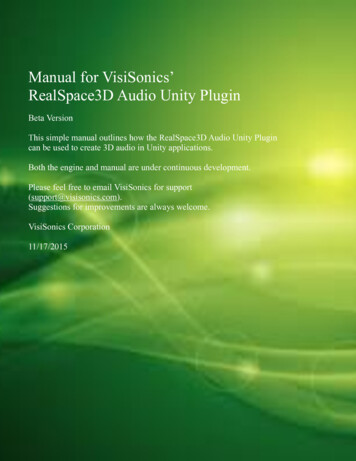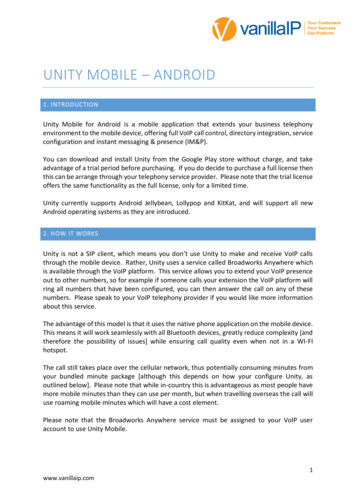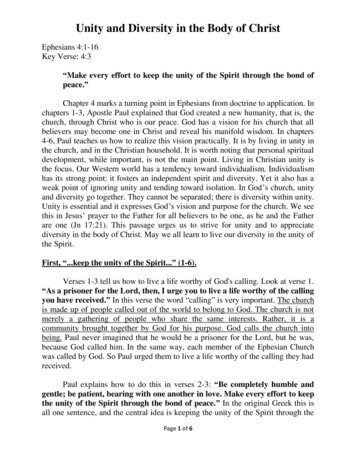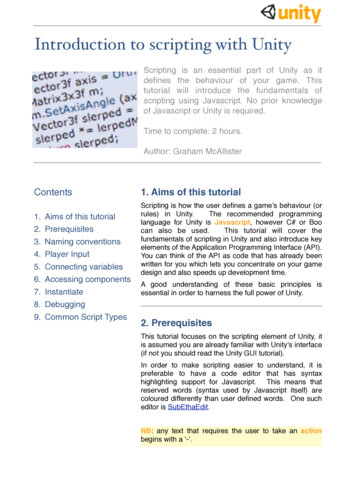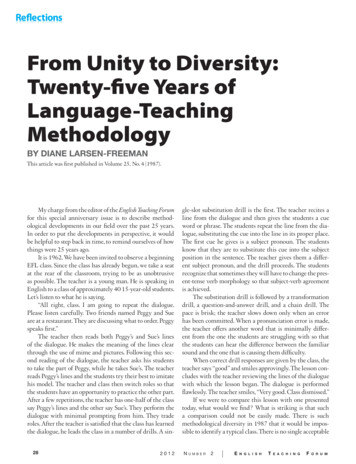
Transcription
From Unity to Diversity:Twenty-five Years ofLanguage-TeachingMethodologyBY DIANE LARSEN-FREEMANThis article was first published in Volume 25, No. 4 (1987).My charge from the editor of the English Teaching Forumfor this special anniversary issue is to describe methodological developments in our field over the past 25 years.In order to put the developments in perspective, it wouldbe helpful to step back in time, to remind ourselves of howthings were 25 years ago.It is 1962. We have been invited to observe a beginningEFL class. Since the class has already begun, we take a seatat the rear of the classroom, trying to be as unobtrusiveas possible. The teacher is a young man. He is speaking inEnglish to a class of approximately 40 15-year-old students.Let’s lis ten to what he is saying.“All right, class. I am going to repeat the dialogue.Please listen carefully. Two friends named Peggy and Sueare at a restaurant. They are discussing what to order. Peggyspeaks first.”The teacher then reads both Peggy’s and Sue’s linesof the dialogue. He makes the meaning of the lines clearthrough the use of mime and pictures. Following this second reading of the dialogue, the teacher asks his studentsto take the part of Peggy, while he takes Sue’s. The teacherreads Peggy’s lines and the students try their best to imitatehis model. The teacher and class then switch roles so thatthe students have an opportunity to practice the other part.After a few repeti tions, the teacher has one-half of the classsay Peggy’s lines and the other say Sue’s. They perform thedialogue with minimal prompting from him. They traderoles. After the teacher is satisfied that the class has learnedthe dialogue, he leads the class in a number of drills. A sin282012gle-slot substitution drill is the first. The teacher recites aline from the dialogue and then gives the students a cueword or phrase. The stu dents repeat the line from the dialogue, substituting the cue into the line in its proper place.The first cue he gives is a subject pronoun. The studentsknow that they are to substi tute this cue into the subjectposition in the sentence. The teacher gives them a different subject pronoun, and the drill proceeds. The studentsrecognize that sometimes they will have to change the present-tense verb morphology so that subject-verb agreementis achieved.The substitution drill is followed by a transformationdrill, a question-and-answer drill, and a chain drill. Thepace is brisk; the teacher slows down only when an errorhas been committed. When a pronunciation error is made,the teacher offers another word that is minimally different from the one the students are struggling with so thatthe students can hear the difference between the familiarsound and the one that is causing them difficulty.When correct drill responses are given by the class, theteacher says “good” and smiles approvingly. The lesson con cludes with the teacher reviewing the lines of the dialoguewith which the lesson began. The dialogue is performedflawlessly. The teacher smiles, “Very good. Class dis missed.’’If we were to compare this lesson with one presentedto day, what would we find? What is striking is that sucha comparison could not be easily made. There is suchmethod ological diversity in 1987 that it would be impossible to iden tify a typical class. There is no single acceptableNumber2 En g l i s hTe a c h i n gFo r u m
way to go about teaching language today. Indeed, the existing ap proaches to language teaching differ in fundamentalways: There is little or no accord on syllabus type, on materials used, on the order of skill presentation, on the value ofex plicit error correction, or even on such a basic issue as therole of the students’ native language.This is not to say that there is no agreement in thefield about what constitutes good teaching practice. Indeed,in a 1987 classroom we might expect to find little or nomeaning less repetition, meaning made clear through a variety of techniques, more student-to-student interaction,and lan guage being presented in all its communicativerichness. But before we proceed with a discussion of whatis acceptable practice today, it would be worthwhile tracingthe historical antecedents of modern methodology.I have found it helpful to think of methodology being de picted as a triangle, with each angle of the trianglerepresent ing a basic area of the field. The first angle mightbe termed language learning/language learner. Questionsaddressed from this perspective include what is the natureof the language acquisition/learning process, who is doing thelearning, and what are the factors that influence the learner?The second angle has to do with the subject matter weteach. What is the nature of lan guage/culture is the questiondealt with in this angle. The third angle comprises bothlanguage teaching as a process and the role of the languageteacher as an agent in the proc ess. It is defined in part by answers to the questions posed in the other two angles. Eachof these perspectives is indispensable to viewing methodology as a whole.It would be useful at this point to review developmentsduring these past 25 years, considering each of these anglesin turn.Language Learning/Language LearnerThe prevailing view of the language-learning processin 1962 was that learning was achieved through habitforma tion. The native language was seen to comprise habitsthat a second-language learner must overcome. As we sawEn g l i s hTe a c h i n gFo r u m Number2in the language lesson we observed, this was to be accomplished by forging new habits through repetition, patterndrills, and accompanying positive reinforcement by theteacher. Errors were to be avoided if at all possible. A way toanticipate er rors was to conduct a contrastive analysis, comparing and contrasting the students’ native language withthe target lan guage. Through this means, potential troublespots could be identified. If an error was committed, quickcorrection was desirable in order to prevent the establishment of bad habits. Overlearning leading to automaticitywas the goal.Challenging this characterization of the learning process was Noam Chomsky (1959). Chomsky argued thatlanguage acquisition could not take place through habitformation be cause language was far too complicated to belearned in such a manner, especially given the brief timeavailable. There must be, Chomsky reasoned, some innate capacity that hu mans possessed which predisposedthem to look for basic patterns in language. Furthermore,people could create and comprehend novel utterances—utterances they could not possibly have encountered in thelanguage that was spoken to them. This observation wassupported by evidence from children learning English asa native language. Overgenerali zation errors such as *eatedand *sleeped were common in chil dren’s speech. Such errorssuggested that children were not repeating what was said tothem, but rather were attempting to induce the rules for thepast tense from the language to which they were exposed.Thus, through a process of detecting patterns in the inputlanguage, forming hypotheses based on these about howthe language worked, testing these hypotheses and revisingthem in light of contradictory evidence, little by little thegrammar of the native language would be acquired.What is especially significant for us was that learners ac quiring English as a second or foreign language werefound to be committing the same sort of overgeneralizationerrors as the children. Furthermore, the second-languagelearners did not commit the errors randomly but in a systematic way, indicating that they may have been followinga more or less natural progression in their acquisition ofEnglish. Corder (1967) even suggested that learners mightnaturally adhere to a learner-generated or “built-in” syllabus. The language the learners spoke was termed an interlanguage (Selinker 1972), since it was intermediate betweenthe native language and target language. By the very terminterlanguage we can see that it was considered to be a language in its own right, sub ject to the same constraints asany other natural language. Moreover, any point along theinterlanguage continuum was held to be fully describableby grammatical rules.201229
One cannot fail to note that viewing language acquisition as a process of rule formation had tremendous implications for the role of the learners. Rather than being seenas passive imitators of carefully controlled language input,learners were seen to be active agents involved in a process of “cre ative construction.” Errors were not somethingto be avoid ed, but rather were regarded as welcome signsthat learners were actively testing hypotheses. Rather thanseeing the native language as a source of interference, thenative language was a source of hypotheses about how thetarget language functioned. Thus, language learning wasseen to be a natu ral, cognitive process with learners ultimately responsible for their own learning.With this shift of focus to the active role of the learner,an other serious question motivated much research: thedifferential success question. Why was it, second-languageacqui sition researchers asked, that while all children withnormal faculties were able to achieve native-speaker status,rarely (if ever) were second-language learners able to attain the same level of achievement? During the years thatfollowed, many factors were hypothesized to enhance orinhibit the second language acquisition capability of learners: social, motiva tional, affective, aptitude, personality, experiential, instruc tional, biological, and cognitive (see, forexample, Schumann 1978). It has also been suggested thatsuccessful language learners employ more effective learning strategies than less successful learners (Rubin 1975) andthat more success in language learning might be achievedif teachers engaged in learner training as well as languagetraining (Wenden 1985).From this recent suggestion, we see that in 1987 learners are still seen to be the bearers of responsibility for howmuch learning takes place. What has changed somewhatsince Chomsky first proposed it, however, is the view thatlan guage learning is solely a process of rule formation.While still assigning to the learner an active role of siftingthrough incoming data and testing hypotheses which eventually lead to the restructuring of the learner’s interlanguage, the view of what the learner tests hypotheses abouthas shifted some what. Working within the framework ofUniversal Grammar proposed by Chomsky’s (1981) Government-Binding The ory, second-language researchers (e.g.,White 1985) have been exploring the idea that grammaracquisition involves setting or fixing the parameters ofprinciples of the Universal Grammar in a manner consistent with the data of a particular language.Other second-language researchers such as Schmidt(1983) feel that the role of imitation has been seriouslyoverlooked in recent years. While not denying that language acquisition takes place at least in part through rule302012formation, Schmidt also believes a great deal of acquisitionof language is brought about by learners having memorizedsentences and phrases (e.g., How are you? I beg your pardon.You know what I mean?). The successful employment ofthese memorized for mulae contributes greatly to learnerfluency, Schmidt feels.Finally, researchers like Hatch (1983), while againnot de nying that grammatical competence is achievedthrough linguistic hypothesis testing, nevertheless believethat nonlin guistic processes may be critical to the learner’ssuccess in this endeavor. Hatch specifically discusses thevalue of na tive-speaker/nonnative-speaker interaction inwhich the native speaker adjusts the level of speech to accommodate the nonnative speaker’s comprehension. Theseforeigner-talk adjustments, Hatch believes, “help promotecommunica tion, help establish an affective bond andcan serve as either an explicit or implicit teaching mode”(1983:183).We will return to our consideration of learning and thelearner when we discuss the impact of these views on language pedagogy. But before we do, let us turn to the secondmajor angle of our triangle—that dealing with the natureof the language and culture we teach.Language/CultureSyllabus designInfluenced by structural linguistics, in 1962 languagewas seen as consisting of hierarchically organized strata,each dealing with a different linguistic structure: phonemes, mor phemes, and syntactic patterns. It was theseaspects of lan guage, of course, that were drilled in the lesson we observed. Syllabi for a language course were organized around linguis tic structures, carefully graded in asequence from simple to complex. If one were studying in abeginning-level English course, therefore, one would likelywork on sentence pat terns with the BE verb early on (She isa teacher.), followed a few lessons later by yes-no questions(Is she a teacher?), fol lowed by short answers (Yes, she is. ), etc.Despite the profound effect of the Chomskyan revolution in other areas, it did little to alter the way languagewas presented for pedagogical purposes. Like the structuralists be fore them, the transformational grammarians focused upon sentence-level syntax. It was thus not until thelate 1960s that sociolinguist Hymes (1966) introduced thedistinction between linguistic competence and communicative competence. Whereas linguistic competence isunderstood as the unconscious knowledge of languagestructure of the ideal speaker-listener, communicative competence is the knowledge of how to use language appropriNumber2 En g l i s hTe a c h i n gFo r u m
ate to a given social situation. When the goal of languageinstruction shifted to developing students’ communicative competence, teachers were asked not to focus on thegrammatical rules of usage that enable speakers to composecorrect sentences so much as on the use of language toaccomplish some kind of commu nicative purpose (Widdowson 1978:3).This new focus had important implications for syllabusde sign, and Wilkins’ (1976) advocacy of an analyticalnotional functional syllabus over a synthetic structuralone was one manifestation of this shift in viewing language. Adopting a notional-functional syllabus meantbuilding a course around the uses or functions to whichlanguage is put. For example, one might work on requestinginformation in one lesson, apologizing in another, and expressing gratitude in a third. Since it was not obviously thecase that certain functions would be simpler than others,grading according to function al complexity did not makesense. Wilkins proposed instead that the functions be recycled, that is, re-introduced several times. Earlier cyclesmight contain relatively unmarked forms of the functionsexpressed in linguistically simple ways. Successive cycleswould introduce more linguistically complicated and moremarked (e.g., very formal) forms. Thus, the first time students were taught how to introduce one person to another,they might just learn to say “This is.” Sometime later, in asubsequent lesson, they might learn “I’d like you to meet.” In yet another, they would learn “Allow me to introduce you to .”More recently, applied linguists Krashen and Terrell(1983) advised basing courses on topics (e.g., family, clothing, weather) and situations (e.g., a job interview, a visit tothe doctor, a shopping trip). In presenting the language,struc tural and functional diversity would be perfectly acceptable, with importance given to the teacher’s gettingacross a com prehensible message. Krashen and Terrell’sfocus was thus on the meaning or semantic dimension oflanguage.The structural, the notional-functional, and thesemantic -based syllabi nicely illustrate the fact that language consists of three interacting dimensions: form, function, and meaning. Any course that takes having studentsachieve communicative competence as its goal must include all three (Larsen-Freeman and Celce-Murcia, inpreparation). Thus, if a teacher were using a structural syllabus and the unit to be presented was on the passive voice,the teacher must teach not only how to form the passive,but also what it means (it has a “grammatical meaning” ofputting the focus on the theme rather than on the agent)and what its function is, i.e., when it should be used (seeEn g l i s hTe a c h i n gFo r u m Number2Celce-Murcia and Larsen-Free man 1983). The same wouldbe true if one were using a no tional-functional syllabus. Ifa teacher were teaching the function of apologizing, for example, and wanted students to end up with more than somememorized formulae for apologizing, such as they mightget from a phrase book, the teacher would have to workwith the students on the gram matical form and meaningof the apologies. Wilkins, of course, recognized this whenhe wroteThe grammar is the means through which linguistic creativity is ultimately achieved and aninadequate knowledge of the gram mar would leadto a serious limitation on the capacity for com munication. A notional syllabus, no less than agrammatical syl labus, must seek to ensure that thegrammatical system is properly assimilated by thelearners. (1976:66)Unfortunately, in our enthusiasm to embrace the notion of communicative competence, I fear we may haveemphasized the functions too much over the forms andthus have sacri ficed accuracy to fluency (Eskey 1983).Both, in my opinion, are an integral part of communicativecompetence.In addition to the three types already mentioned, manyother syllabus types exist these days, of course. One particu larly interesting approach is the procedural syllabus (Prabhuand Carrol 1980), which does not take language as its basisat all. Instead, students learn language through the perfor mance of certain tasks and activities. Prabhu and Carrol’sstudents have already studied English following a structural syllabus. Instructors using a procedural syllabus, therefore, are concerned with the activation of their students’already learned grammar.Another syllabus, one that has had impact on the teaching of ESL in the United States, is competency-based (Grognetand Crandall 1982). This type of syllabus has been developed to teach survival skills to refugees who are newlyarrived immi grants to the United States. The behavioraloutcomes of com petency-based instruction are specific survival skills: e.g., students will be able to identify food items,read food labels, make food purchases, and verify that theyhave received the correct change.One final language-related development that weshould not fail to mention is the expanded view of languageto in clude discourse or the structure that exists beyond thesen tence level. While acknowledging the importance of student mastery of sentence-level syntax, it is now commonlyrecog nized that explicit teaching will need to be directed to201231
the structure of language at the suprasentential or discourselev el (Larsen-Freeman 1980). Thus, students will have tolearn to produce oral and written texts that are both coherent and cohesive.English for special purposesSo far we have discussed general communicativecompe tence as being a desirable goal to strive for in alanguage course. Another major trend having to do withlanguage during these past 25 years is the teaching of English for Spe cial Purposes (ESP). Although all language usehas a pur pose, teachers of ESP teach only the English requisite for a particular purpose, be it an occupation (e.g., English for business or for airline pilots) or a domain (e.g., English for Science and Technology or English for AcademicPurposes). Thus, curriculum designers of ESP courses conduct rigorous needs analyses—analyzing the situation inwhich students will likely find themselves and carefullyselecting the English necessary for students to meet thelanguage demands of these restricted domains.Content-based approachesClosely aligned to the ESP movement, at least in termsof their theoretical justification, are the content-basedap proaches (Mohan 1986) that are currently popular inCanada and the United States. Advocates of both ESPand content-based approaches see language as a means ofachieving something else and not as an end in itself (Widdowson 1983:108–109). In content-based approaches, thelearning of language is integrally linked with the learningof some other subject matter. The best-known example isthat of bilingual education/immersion education, in whichmonolingual chil dren at the elementary and secondarylevels receive the ma jority of their instruction in the target language (Swain 1981). Although various models existin this approach, some con taining explicit instruction inthe target language, the as sumption is that both the subjectmatter and the language can be learned together when thestudents’ focus is on ac quiring subject-matter information.Other models that share this assumption are thoseprovid ing “sheltered English” and those that follow theadjunct model. Sheltered English classes are employed toteach English and subject content using specially modified curricula and materials (Curtain 1986). Students attend these only dur ing a transitional period until theyhave acquired sufficient English to participate fully inregular courses. The adjunct model calls for ESL studentsto attend content courses that are linked with languagecourses through a coordinated syllabus (Snow and Brinton 1984). ESL teachers and students attend authentic322012lectures in an introductory psychology course, for instance, and later the teachers assist the students withcomprehending the lecture and doing the homework assignments. Assignments made in the ESL components arebased on the content course; in addition, the developmentof study skills is emphasized.One final model should be mentioned in the discussion of content-based approaches to English-languageacquisition. This is the “Writing across the Curriculum”approach developed in response to the 1975 Bullock Report’s recommenda tion that there be a policy to teachlanguage across the curric ulum in British schools. By receiving writing assignments in each of their content-areasubjects, students learn to write, in addition to learningthe content.CultureThe second angle of our triangle embraces both language and culture. Many language teachers acknowledgethe need to integrate the two; yet I think it is fair to saythat there really is no well-articulated theory of culturethat has informed our field during the last 25 years, andhence that the means of teaching culture to language students have not been well de veloped. It is true that manytexts contain cultural informa tion in the form of cultural capsules, i.e., short notes describ ing the differencesbetween the native and target cultures. But knowing aculture involves so much more than the trans mission ofinformation these cultural notes allow. Indeed, developing in one’s students an understanding of the atti tudes,values, beliefs—the “world view” (Fantini, personal communication)—of a particular target culture is at least asimportant as imparting factual knowledge such as whatfoods one can/cannot order in a restaurant, in whichdenomi nations the currency comes, etc. I do not mean tobelittle the value of such cultural information, but all toooften the other aspects of culture are ignored. They aresometimes ad dressed through studying the literature ofthe target culture. But, of course, this does not guaranteethat students will ar rive at a comprehensive, accurate, andup-to-date under standing of the target culture.Having just cited the need for a coherent theory ofculture and an expanded repertoire of techniques for theteaching of culture, I would be remiss if I did not mentionanother language-related trend with methodological implications that takes quite an opposite view from this withregard to the teaching of culture. I am speaking, of course,of the English-as-an-international-language perspective(see, for example, Strevens 1978). Many applied linguistswho hold this per spective value the pluralism that exists inNumber2 En g l i s hTe a c h i n gFo r u m
the English-speak ing world (Indian English, SingaporeanEnglish, Nigerian English, etc.) and feel that one can be bilingual without being bicultural, that one can and shouldlearn English for utilitari an purposes without adopting thedominant target culture.Language Teaching/TeacherThis article began with our visit to a class in which theAu dio-lingual Method (ALM) was being used. Surely it isthe case that in many classrooms in the world today, theALM is still being practiced. However, it is also true that theALM fell into disfavor in many circles in the 1960s. Thiswas due in part to the refutation of the habit-formation theory of lan guage acquisition and in part to the fact that bothteachers and students often found the required repetitionboring and unmotivating. Finally, there was the widespreadobserva tion that patterns mastered in the classroom werenot always transferred outside when “real communication”was in volved.In the past 25 years, no single method of languageteach ing has assumed the dominance of the ALM, althoughwe have witnessed the birth and maturing of at least fiveinnova tive methods during this period. It would be worthour while to consider each of these now, even though spacewill not permit us to do anything more than to introducethem. (For further details, see Larsen-Freeman 1986.)Silent wayThe emphasis on human cognition inspired by theChom skyan revolution led to a new general approach tolanguage teaching termed cognitive code. As we saw earlier,rather than simply being responsive to stimuli in the environment, learners were seen to be much more activelyinvolved in their own learning. Although Caleb Gattegno’sSilent Way (1972) did not evolve directly from the cognitive-code approach, its principles are consistent with it. Forexample, one of the ba sic tenets of the Silent Way is “thesubordination of teaching to learning.” This principle is inaccord with the active role ascribed to the learner in thecognitive-code approach. An other shared principle is thaterrors are inevitable and are signs to the teacher that theiearner is exploring new areas of the language. Learning isthus seen to be gradual, involving imperfect performanceat the beginning. Another distinguishing feature of the Silent Way is that the teacher helps students to develop a wayto learn on their own. By giving students only what theyabsolutely need, by assisting them to develop their own“inner criteria,” and by remaining si lent much of the time,the teacher tries to help students to become self-reliant andincreasingly independent of the teacher.En g l i s hTe a c h i n gFo r u m Number2SuggestopediaGeorgi Lozanov, the originator of Suggestopedia, be lieves, as does Gattegno, that language learning can be mademore efficient than what usually occurs. Lozanov (1978)feels that the inefficiency is due to the psychological barriers learners establish—their fear of failure is one of them.Teach ers can help learners to surmount these barriers andto fully tap their mental powers, by desuggesting the learners’ self-imposed limitations. This can be done through theteacher’s direct and indirect positive suggestion in an environment that is relaxing and therefore conducive to learning. When learners trust in the authority of the teacher,Lozanov as serts, they will reach a state of infantilization—adopting a childlike role. If they feel secure, learners can bemore spon taneous and less inhibited.Counseling-learning/community language learningAnother methodologist who advises that we shouldsee learners as “whole persons,” not just cognitive beings,is Charles Curran (1976). Through his research, Curran discov ered that adult learners, in particular, are oftenthreatened in learning situations. They feel threatened bythe fact that learning requires them to change. In Curran’sCounseling Learning/Community Language Learningmethod, teachers understand and accept their students’fears and concerns. In addition, teachers try to provide asecure learning environ ment in which a sense of community is fostered. In such an atmosphere, students can benondefensive and their positive energies can be channeledtowards the language-learning task. Another essential element in learning, Curran believes, is for students to takesome initiative for their own learning and to make someinvestment in what they will learn. There fore, in Community Language Learning students decide what it is theywant to be able to say in the target language. Another way ofputting this is to say the syllabus is learner-generated.Comprehension approachAdvocates of the Comprehension Approach (Winitz1981) also acknowledge that learner insecurities have anadverse effect on language acquisition. As a consequence,practitio ners of this approach do not put students on thespot by hav ing them speak in the target language. Instead,students spend the hours at the beginning of instructionlistening to the teacher speak the target language, muchas children learn their native language by attending tothe language spo ken to them. The teacher insures that thelanguage he or she uses is comprehensible to the students,just as parents modi fy the speech they use with their chil201233
dren. A child does not speak until ready to do so; so students choose when to begin to use the target language. Likea child, their initial speech exhibits much imperfection atfirst. Only later, when stu dents are comfortable speakingthe language, is their speech “fine-tuned.” Two of the bestknown methods associated with this approach are the TotalPhysical Response (Asher 1982) and the Natural Approach(Krashen and Terrell1983).Communicative approachAdherents of the Communicative Approach (e.g.,Johnson and Morrow 1981) assert that students’ motivation will be enhanced if they feel that they are working oncommunica tive skills, i.e., practicing some function withina social con text, not just a
Language Learning/Language Learner The prevailing view of the language-learning process . in 1962 was that learning was achieved through habit . formation. The native language was seen to comprise habits that a second-language learner must overcome. As we saw in the language lesson we observed, this was to be accom-







